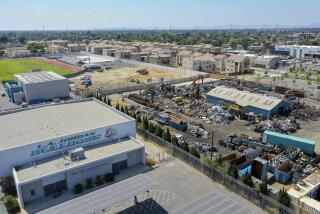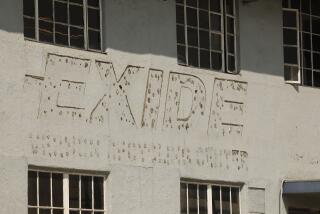Radioactive Pellet Takes a Perilous Path : Shipping: Cargo passed undetected through the Port of L.A. It was trucked across country before the danger was discovered.
- Share via
Outwardly, nothing was amiss when a 40-foot-long container was unloaded last February at the Port of Los Angeles after an 11-day voyage aboard the cargo ship Hanjin Mokpo from South Korea.
The container was stacked on the docks, and a day or so later was hauled about 20 miles to a Compton warehouse, where clerks unpacked the cargo, including a battered plywood crate. Soon the crate was loaded on a truck for a three-week, cross-country trip.
It wasn’t until the crate reached its final destination at Amersham Corp., northwest of Boston, that an alarm sounded, warning that the cargo contained potentially dangerous levels of radiation.
The incident touched off a far-reaching federal investigation into how the shipping crate slipped undetected through the harbor, crossed the country by truck and exposed dozens of unsuspecting people to a pellet of Iridium-192, a radioactive isotope typically used to X-ray the strength of industrial welds. It also has rekindled debate over the safety of shipping radioactive materials on the nation’s highways.
The crate contained 14 stainless steel carrying cases designed to transport radioactive materials used for industrial purposes. The shippers believed that the cases were empties being returned to Amersham, which manufactures and distributes radiographic materials.
What workers who handled the crate on the docks, at the warehouse and in the truck didn’t know was that one of the supposedly empty cases contained a radioactive pellet.
They were also unaware that somewhere en route to Massachusetts the pellet had become dislodged from the side of the carrying case designed to shield the public from radiation.
A 150-page report released in May by the U.S. Nuclear Regulatory Commission concluded that the shipment of the pellet was inadvertent and that no one was exposed to doses of radiation large enough to significantly increase their risk of getting cancer. But it cautioned that the pellet “had the potential to cause high radiation exposure to members of the general public.”
After tracking the crate’s movements, investigators placed the blame on the South Korean shippers for allegedly failing to heed U.S. government safety rules by not labeling the crate and its contents as radioactive. There were no warning signs on the truck that took the cargo cross-country--through parts of Los Angeles, Orange and San Bernardino counties as well as the cities of Albuquerque, Oklahoma City, St. Louis, Baltimore and Philadelphia.
The U.S. Department of Transportation is continuing to look into the shipment and is “considering taking enforcement action” against those responsible in South Korea, said John O’Connell, an official in the department’s office of hazardous materials. The shippers could face civil fines of up to $10,000 a day for each day the shipment was in transit.
In fact, the South Korean shipper, NDI Corp., believed the containers were empty, according to K. Y. Kim, the company’s president. But he acknowledged that his firm failed to adequately check the carriers before packing them.
However, even if the crate and shipping papers were properly labeled, “nothing would have changed” in the way it was transported because no one knew the radioactive source had been dislodged from the carrying case’s shielded portion, according to Willard Brown, who headed the Nuclear Regulatory Commission team that probed the accident.
The failure to follow shipping regulations is “sort of a moot point,” Brown said, because “what (the South Koreans) failed to do was test the units before they were shipped.”
Brown said that between 1985 and 1989 there were at least nine other unmarked shipments from South Korea. But in those cases, he said, the radioactive source remained in the shielded half of the compartment.
The Amersham incident points out gaps in the government safety system devised to protect the public from potential accidents involving nuclear shipments.
The U.S. Department of Energy estimates that every year at least 2 million shipments of radioactive materials are transported across the nation in trucks, trains, planes and barges. Almost two-thirds of the shipments are for medical purposes, with the balance used in nuclear power plants, industry and research.
Although federal investigators minimize the risk associated with the Amersham incident, the Sandia National Laboratory in New Mexico says that between 1971 and 1989 there were 3,213 radioactive packages involved in transportation accidents. Forty-six of those accidents involved packages designed to withstand major wrecks without releasing their contents. None of the accidents have exposed the public to radiation.
However, people have been exposed to radiation released in accidents involving lower-level nuclear products carried in weaker kinds of packages, the lab reported. Most involved only small amounts of radioactive materials.
Ken Bossong, director of the Critical Mass Energy Project, the energy policy arm of consumer activist Ralph Nader’s Public Citizen research group, favors shipping radioactive materials by freight train instead of over highways, maintaining that railroads have a better safety record than trucks.
“These shipments pose a constant and understated danger to persons along the transportation routes,” Bossong said.
But Gary Sandquist, director of nuclear engineering at the University of Utah and the author of a recent study for the Department of Energy on transporting radioactive materials, said the benefits to industry outweigh the relatively small risks to the public of transporting radioactive materials. “Society has to learn to take the risk,” he said.
Edith B. Page, a senior associate at the Office of Technology Assessment, a research arm of Congress, said shipments from Third World countries are plagued by problems. “International shipments are a problem because packaging and marking requirements in other parts of the world . . . are not precisely the same as they are here,” she said.
Los Angeles port officials maintain there was nothing they could have done to identify as potentially hazardous an unmarked shipment such as the one sent to Amersham. The port has no detectors to monitor radioactive packages, and officials said they would not be practical anyway.
“We can’t look in every box that comes into this port,” said Ron Kennedy, director of operations at the port, citing the movement of 2 million shipping containers in and out of the harbor every year. Port officials say they do not keep records on the amount of radioactive products that move through the waterfront, but they say it is small.
A spokesman for the trucking company that handled the shipment, Chattanooga, Tenn.-based Covenant Transport, said there was no way for his firm to know something was amiss. David Frady, Covenant’s safety director, said that because his firm was unaware of the pellet, “there’s nothing . . . that we or any other trucking company could do to prevent this.”
After the truck carrying the pellet drove into a Patriot Trucking Co. warehouse in Boston, the truck driver, John A. Fritz noticed the crate was “severely damaged” and some of the carrying cases “had been knocked out of the crate,” according to the Nuclear Regulatory Commission.
When repacking the cases, “he noticed the radioactive material labels” on the carrying cases and “became concerned about the status of the shipment,” a commission report said. Fritz told The Times that the outside of the box was marked only “Handle With Care.”
Fritz said he picked up the cases and placed them back in the box, which appeared to have been damaged by a forklift. When Fritz alerted Covenant, he was told the 65-pound cases were all empty.
It wasn’t until the shipment reached Amersham that a monitor worn by an employee sounded.
Marvin Resnikoff, a physicist who operates a public interest consulting firm in New York, said the pellet’s transcontinental trip demonstrates that it is possible “for radioactive materials to move across the United States and expose lots of people and have no one notice.
“There’s a basic problem in the system because the NRC doesn’t regulate what’s happening in Korea,” he said. “This can happen again.”
Times staff writer Ralph Frammolino contributed to this story.
TRUCK ROUTE OF NUCLEAR SHIPMENT
A wooden crate containing a highly radioactive pellet arrived Feb.11 at the Port of Los Angeles from South Korea. It was stored for a day near Berth 127 before being moved to a Compton warehouse for a shipment to Boston. In March the crate triggered alarms when it went through radiation detectors at a Massachusetts manufacturing plant, and it was discovered that the pellet contained Iridium-192. A two-month investigation sought to determine how the crate slipped through the port undetected and crossed the country, exposing dozens of people to the radioactivity.
1. 2/11/90 Shipment arrived Hanjin shipping terminal Los Angeles Harbor.
2. 2/16/90 Departed Nova warehouse in Compton.
3. 2/17/90 Remained overnight at motel in San Bernardino because Cajon Pass was closed by snow, then departed San Bernardino.
4. 3/8/90 Amsterdam Corp.
Source: U.S. Nuclear Regulatory Commission.
More to Read
Sign up for Essential California
The most important California stories and recommendations in your inbox every morning.
You may occasionally receive promotional content from the Los Angeles Times.









